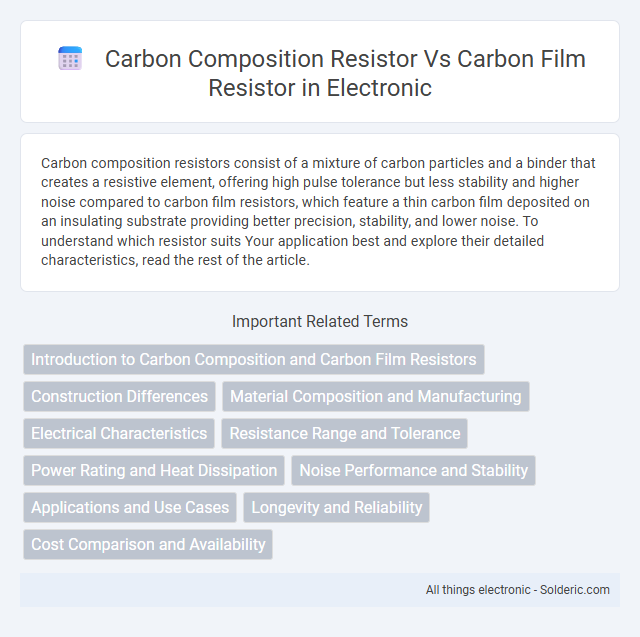Carbon composition resistors consist of a mixture of carbon particles and a binder that creates a resistive element, offering high pulse tolerance but less stability and higher noise compared to carbon film resistors, which feature a thin carbon film deposited on an insulating substrate providing better precision, stability, and lower noise. To understand which resistor suits Your application best and explore their detailed characteristics, read the rest of the article.
Comparison Table
| Feature | Carbon Composition Resistor | Carbon Film Resistor |
|---|---|---|
| Construction | Mixed carbon particles pressed into a cylindrical shape | Thin carbon film deposited on ceramic substrate |
| Tolerances | +-5% to +-20% | +-1% to +-5% |
| Noise Level | High noise due to granular structure | Low noise, stable performance |
| Power Rating | Typically 0.25W to 2W | Typically 0.125W to 1W |
| Temperature Stability | Poor stability with temperature changes | Better temperature coefficient |
| Lifespan | Shorter lifespan, prone to aging | Longer lifespan, more reliable |
| Applications | High energy pulses, vintage electronics | General purpose circuits, precision applications |
| Cost | Generally cheaper | Moderate price, costlier than carbon composition |
Introduction to Carbon Composition and Carbon Film Resistors
Carbon composition resistors consist of a solid cylindrical resistive element made by mixing carbon powder with a binder, offering high energy pulse tolerance but with less precision and higher noise levels. Carbon film resistors, made by depositing a thin carbon film onto an insulating substrate, provide better tolerance, stability, and lower noise compared to carbon composition types. Your choice between these resistors depends on the specific application requirements, including durability, precision, and electrical noise considerations.
Construction Differences
Carbon composition resistors consist of a solid cylindrical resistive element made from a mixture of carbon powder and a binding resin, offering a bulk composition throughout the entire resistor body. Carbon film resistors feature a thin layer of carbon film deposited on an insulating ceramic rod, with the film thickness precisely controlled to achieve the desired resistance value. Your choice between these depends on factors like stability, noise level, and manufacturing tolerance, with carbon film resistors typically providing better precision and reliability.
Material Composition and Manufacturing
Carbon composition resistors consist of a solid mixture of carbon particles and a ceramic or resin binder, molded into a cylindrical shape and baked to set the material. Carbon film resistors are made by depositing a thin layer of carbon film onto an insulating ceramic core through a controlled vapor deposition process, allowing precise resistance values. The manufacturing process of carbon film resistors provides better tolerance and stability compared to the more variable carbon composition types.
Electrical Characteristics
Carbon composition resistors exhibit higher noise levels and less stability under varying temperatures and humidity compared to carbon film resistors, which deliver lower noise and better tolerance accuracy. Carbon film resistors have a thinner resistive carbon layer deposited on an insulating substrate, leading to more consistent resistance values and improved long-term reliability. The temperature coefficient of resistance (TCR) in carbon film resistors is significantly lower, enhancing precision in electronic circuits demanding stable resistance performance.
Resistance Range and Tolerance
Carbon composition resistors typically offer a resistance range from 1 ohm to 22 megohms with a tolerance of +-5% to +-10%. Carbon film resistors provide a broader resistance range, usually from 10 ohms to 10 megohms, with tighter tolerances around +-1% to +-5%. The enhanced precision and stability of carbon film resistors make them suitable for applications requiring more accurate resistance values compared to the wider tolerance of carbon composition resistors.
Power Rating and Heat Dissipation
Carbon composition resistors typically have lower power ratings, often around 0.25 to 0.5 watts, and exhibit less efficient heat dissipation due to their bulk carbon mixture construction. Carbon film resistors, constructed with a thin carbon layer on a ceramic substrate, generally offer higher power ratings up to 2 watts and better heat dissipation capabilities, making them more suitable for applications requiring sustained power handling. When selecting between the two, consider your circuit's power demands and thermal management needs for optimal reliability.
Noise Performance and Stability
Carbon composition resistors exhibit higher noise levels due to their granular construction, making them less suitable for low-noise applications compared to carbon film resistors. Carbon film resistors provide better stability and lower noise performance because their uniform carbon layer reduces microphonic effects and drift over time. Choosing a carbon film resistor enhances Your circuit's reliability in precision and low-noise environments.
Applications and Use Cases
Carbon composition resistors are commonly used in high-energy pulse applications and vintage electronics due to their ability to withstand surges and dissipate energy quickly, making them ideal for power supplies and amplifiers. Carbon film resistors, favored for their stability, lower noise, and precision, are widely applied in modern electronics, including audio equipment, measurement devices, and general-purpose circuits where accuracy and reliability are critical. Your choice depends on the application's need for durability under stress (carbon composition) versus precision and noise performance (carbon film).
Longevity and Reliability
Carbon film resistors generally offer superior longevity and reliability compared to carbon composition resistors due to their stable film deposition process, which minimizes variability and degradation over time. Carbon composition resistors are more prone to resistance drift and noise under environmental stress, leading to reduced lifespan in demanding applications. Their inherent construction makes carbon film resistors preferred in circuits requiring consistent performance and extended operational life.
Cost Comparison and Availability
Carbon composition resistors generally cost more due to their complex manufacturing process and declining production, making them less readily available compared to carbon film resistors. Carbon film resistors benefit from automated production methods, resulting in lower costs and widespread availability across electronic component suppliers. The broader accessibility and reduced price point of carbon film resistors make them the preferred choice for most modern electronic applications.
Carbon composition resistor vs carbon film resistor Infographic

 solderic.com
solderic.com